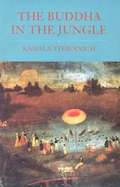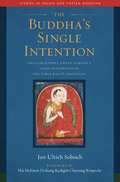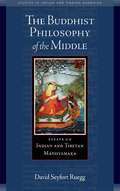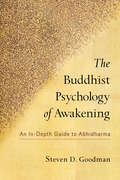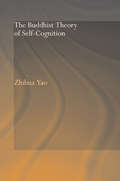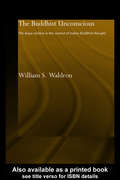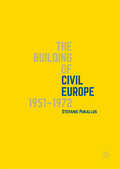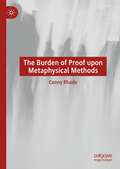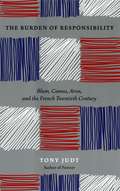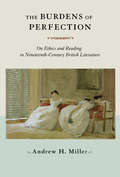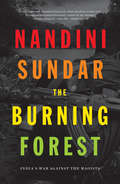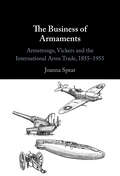- Table View
- List View
The Buddha and Religious Diversity
by J. Abraham Velez de CeaProviding a rigorous analysis of Buddhist ways of understanding religious diversity, this book develops a new foundation for cross-cultural understanding of religious diversity in our time. Examining the complexity and uniqueness of Buddha’s approach to religious pluralism using four main categories – namely exclusivism, inclusivism, pluralistic-inclusivism and pluralism – the book proposes a cross-cultural and interreligious interpretation of each category, thus avoiding the accusation of intellectual colonialism. The key argument is that, unlike the Buddha, most Buddhist traditions today, including Theravāda Buddhism and even the Dalai Lama, consider liberation and the highest stages of spiritual development exclusive to Buddhism. The book suggests that the Buddha rejects many doctrines and practices found in other traditions, and that, for him, there are nonnegotiable ethical and doctrinal standards that correspond to the Dharma. This argument is controversial and likely to ignite a debate among Buddhists from different traditions, especially between conservative and progressive Buddhists. The book fruitfully contributes to the literature on inter-religious dialogue, and is of use to students and scholars of Asian Studies, World Religion and Eastern Philosophy.
The Buddha in Sri Lanka: Histories and Stories
by Gananath ObeyesekereThis book examines culture, religion and polity in the context of Buddhism. Gananath Obeyesekere, one of the foremost analytical voices from South Asia develops Freud’s notion of ‘dream work’, the ‘work of culture’ and ideas of no-self (anatta) to understand Buddhism in contemporary Sri Lanka. This work offers a restorative interpretation of Buddhist myths in contrast to the perspective involving deconstruction. The book deals with a range of themes connected with Buddhism, including oral traditions and stories, the religious pantheon, philosophy, emotions, reform movements, questions of identity and culture, and issues of modernity. This fascinating volume will greatly interest students, teachers and researchers of religion and philosophy, especially Buddhism, ethics, cultural studies, social and cultural anthropology, Sri Lanka and modern South Asian history.
The Buddha in the Jungle
by Kamala TiyavanichA Thai Buddhist and US-trained historian, Tiyavanich weaves together stories about Siam in the 19th and early 20th centuries that illuminate the life of the Buddhist culture. They tell of village monks encountering giant snakes, a Christian missionary gored by an elephant, bandits and boatmen, a dog-bodhisattva, midwives, guardian spirits, and other topics. Distributed in the US by the University of Washington Press. Annotation ©2004 Book News, Inc. , Portland, OR (booknews. com)
The Buddha's Guide to Gratitude: The Life-changing Power of Everyday Mindfulness
by Becca AndersonHow to shift the “focus on what is right in our lives instead of what is missing . . . This book is a guide to increasing your happiness quotient” (Nina Lesowitz, author of Living Life as a Thank You).As it turns out, Buddha had quite a lot to say on the subject of gratitude, including citing it as one of the four keys to the Gate of Heaven. Studies show?and experts counsel?that gratitude is a key component of our happiness. People who are grateful about events and experiences from the past, who celebrate triumphs instead of focusing on losses or disappointments, tend to be more satisfied. Gratitude can help us transform our fears into courage, our anger into forgiveness, our isolation into belonging, and another’s pain into healing. Even in the midst of over-busyness, stress, and chaos, we can find plenty to be glad about, and this book will start your journey towards Zen and gratefulness.The Buddha’s Guide to Gratitude provides you with positive thinking “power tools” that will help you build a more grateful life, including:Mindful meditationsHands-on exercisesProfound practicesInspiring quotationsSpace for notetaking and journalingThought-provoking questions“This book will bring you peace of mind and a happy heart.” —Elise Collins, author of Chakra Tonics“Practicing gratitude is like taking your vitamins?you don’t just take them when you’re sick; you also have to take them to stay healthy.” —Louise Baxter Harmon, author of Happiness A-Z“The most magnetic trait of all time is gratitude! Want to transform your outlook and your life, read and enjoy The Buddha’s Guide to Gratitude.” —Susannah Seton, author of Simple Pleasures
The Buddha's Single Intention: Drigung Kyobpa Jikten Sumgön's Vajra Statements of the Early Kagyü Tradition (Studies in Indian and Tibetan Buddhism)
by Jan-Ulrich SobischThe definitive presentation of one of the most unique and compelling works of classical Tibetan literature.This book presents an influential and extraordinary teaching of the Kagyü tradition of Tibetan Buddhism known as the Single Intention by the master Drigung Jikten Sumgön (1143–1217), along with its chief commentaries, principally the Light of the Sun by Rikzin Chökyi Drakpa (1595–1659). Early in the history of the Kagyü school, the teachings of Jikten Sumgön were condensed into 150 core formulations called vajra statements. These pithy, revelatory statements comprise the Single Intention (Dgongs gcig), which presents the thought of the Buddha and the nature of the ineffable (brjod du med pa) in concise and direct expression. The Single Intention weaves the thread of ineffable mahamudra through the entire fabric of Buddhism. It presents mahamudra as pervading disciplined conduct, meditative concentration, and discriminative knowledge; ground, path, and result; view, practice, and conduct; and the &“three vows&” of pratimoksa, of the bodhisattvas, and of mantra. Jikten Sumgön teaches how the fundamental values and insights revealed by the Buddha are woven into reality and therefore accessible to all. Jan-Ulrich Sobisch manages to convey the unity of the Buddha&’s message both in its particulars and in its scope. His deep and authoritative skill makes this the definitive presentation of one of the most unique and compelling works of classical Tibetan literature.
The Buddha's Teachings As Philosophy
by Mark SideritsA shorter and less technical treatment of its subject than the author&’s acclaimed Buddhism As Philosophy (second edition, Hackett, 2021), Mark Siderits's The Buddha&’s Teachings As Philosophy explores three different systems of thought that arose from core claims of the Buddha. By detailing and critically examining key arguments made by the Buddha and developed by later Buddhist philosophers, Siderits investigates the Buddha's teachings as philosophy: a set of claims—in this case, claims about the nature of the world and our place in it—supported by rational argumentation and, here, developed with a variety of systematic results. The Buddha&’s Teachings As Philosophy will be especially useful to students of philosophy, religious studies, and comparative religion—to anyone, in fact, encountering Buddhist philosophy for the first time.
The Buddha’s Teaching: A Buddhistic Analysis
by G. A. SomaratneThis book approaches the Dhamma, the Buddha’s teaching, from a Buddhistic perspective, viewing various individual teachings presented in hundreds of early discourses of Pali canon, comprehending them under a single systemic thought of a single individual called the Buddha. It explicates the structure of this thought, going through various contextual teachings and teaching categories of the discourses, treating them as necessary parts of a liberating thought that constitutes the right view of one who embraces the Buddha’s teaching as his or her sole philosophy of life. It interprets the diverse individual dhammas as being in congruence with each other; and as contributory to forming the whole of the Buddha’s teaching, the Dhamma. By exploring some selected topics such as ignorance, configurations, not-self, and nibbāna in thirteen chapters, the book enables readers to understand the whole (the Dhamma) in relation to the parts (the dhammas), and the parts in relation to the whole, while realizing the importance of studying every single dhamma category or topic not for its own sake but for understand the entirety of the teaching. This way of viewing and explaining the teachings of the discourses enables readers to clearly comprehend the teaching of the Buddha in early Buddhism.
The Buddhist Analysis of Matter
by Y. KarunadasaA fluent English explanation of the Theravada Buddhist analysis of matter for serious students of Buddhist thought.In The Buddhist Analysis of Matter, renowned scholar Y. Karunadasa interprets the Buddhist view of matter as presented in Theravada Buddhism, based on the Abhidhamma. His comprehensive work draws on both the earlier period containing the seven manuals of the Abhidhamma Pitaka and the later period containing Abhidhammic commentaries, sub-commentaries, and such compendiums as the Abhidhammatthasangaha of Acariya Anuruddha. In order to bring the subject into a wider perspective, and for more precision, Karunadasa considers the (non-Theravada) Vaibhasika and Sautrantika schools of Buddhism—two of the leading non-Mahayana schools with whom the Theravadins had much in common, both of which subscribed to a realistic view of existence—as well as later sources such as the post-canonical commentaries and related literary sources of Theravada Buddhism. This book gives us the first clear picture of the Buddhist analysis of matter as such. Earlier works on this subject have tended to focus on the broad philosophical implications arising from the Buddhist theory of matter and were based more on earlier sources, such as the Pali canonical texts. The Buddhist Analysis of Matter provides a much-needed micro view of the topic with a detailed examination of the Theravadins&’ list of rupa-dammas—the ultimate irreducible factors into which material existence is analyzed. It exposes the basic material elements into which the whole of material existence is resolved and explains their interconnection and interdependence on the basis of conditional relations. It concludes with an understanding of the nature and relevance of the Buddhist analysis of matter in the context of Buddhism as a religion.
The Buddhist Philosophy of the Middle
by Tom J. Tillemans David Seyfort RueggMadhyamaka, the "philosophy of the middle," systematized the Buddha's fundamental teaching on no-self with its profound non-essentialist reading of reality. Founded in India by Nagarjuna in about the second century CE, Madhyamaka philosophy went on to become the dominant strain of Buddhist thought in Tibet and exerted a profound influence on all the cultures of East Asia. Within the extensive Western scholarship inspired by this school of thought, David Seyfort Ruegg's work is unparalleled in its incisiveness, diligence, and scope. The Buddhist Philosophy of the Middle brings together Ruegg's greatest essays on Madhyamaka, expert writings which have and will continue to contribute to our progressing understanding of this rich tradition.
The Buddhist Psychology of Awakening: An In-Depth Guide to Abhidharma
by Steven GoodmanA modern introduction to traditional Buddhist psychology This practical overview of Buddhist psychology outlines step-by-step methods for examining the source of our habitual tendencies and hangups. In order to truly free ourselves from perpetuating patterns of suffering, the Buddha offered a clear system for understanding our psychological dispositions, processes, fixations, and challenges--a system known as the Abhidharma. This tradition has been studied by Buddhists for over two millennia. Professor Steven Goodman has taught on the Abhidharma in both universities and Buddhist retreats for over twenty years, making these traditional teachings accessible for a modern readership for the first time. Goodman explains how becoming aware of our mental patterns can liberate us from cycles of emotional pain and shows how the Abhidharma can be applied to meditation practice through exercises of observation and reflection. This is the go-to manual for anyone interested in the world of Buddhist psychology.
The Buddhist Theory of Self-Cognition (Routledge Critical Studies in Buddhism)
by Zhihua YaoThis highly original work explores the concept of self-awareness or self-consciousness in Buddhist thought. Its central thesis is that the Buddhist theory of self-cognition originated in a soteriological discussion of omniscience among the Mahasamghikas, and then evolved into a topic of epistemological inquiry among the Yogacarins. To illustrate this central theme, this book explores a large body of primary sources in Chinese, Pali, Sanskrit and Tibetan, most of which are presented to an English readership for the first time. It makes available important resources for the study of the Buddhist philosophy of mind.
The Buddhist Unconscious: The Alaya-vijñana in the context of Indian Buddhist Thought (Routledge Critical Studies in Buddhism)
by William S WaldronThis is the story of fifth century CE India, when the Yogacarin Buddhists tested the awareness of unawareness, and became aware of human unawareness to an extraordinary degree. They not only explicitly differentiated this dimension of mental processes from conscious cognitive processes, but also offered reasoned arguments on behalf of this dimension of mind. This is the concept of the 'Buddhist unconscious', which arose just as philosophical discourse in other circles was fiercely debating the limits of conscious awareness, and these ideas in turn had developed as a systematisation of teachings from the Buddha himself. For us in the twenty-first century, these teachings connect in fascinating ways to the Western conceptions of the 'cognitive unconscious' which have been elaborated in the work of Jung and Freud. This important study reveals how the Buddhist unconscious illuminates and draws out aspects of current western thinking on the unconscious mind. One of the most intriguing connections is the idea that there is in fact no substantial 'self' underlying all mental activity; 'the thoughts themselves are the thinker'. William S. Waldron considers the implications of this radical notion, which, despite only recently gaining plausibility, was in fact first posited 2,500 years ago.
The Buddhist and the Ethicist: Conversations on Effective Altruism, Engaged Buddhism, and How to Build a Better World
by Peter Singer Shih Chao-HweiEastern spirituality and utilitarian philosophy meet in these unique dialogues between a Buddhist monastic and a moral philosopher on such issues as animal welfare, gender equality, the death penalty, and moreAn unlikely duo—Professor Peter Singer, a preeminent philosopher and professor of bioethics, and Venerable Shih Chao-Hwei, a Taiwanese Buddhist monastic and social activist—join forces to talk ethics in lively conversations that cross oceans, overcome language barriers, and bridge philosophies. The eye-opening dialogues collected here share unique perspectives on contemporary issues like animal welfare, gender equality, the death penalty, and more. Together, these two deep thinkers explore the foundation of ethics and key Buddhist concepts, and ultimately reveal how we can all move toward making the world a better place.
The Building of Civil Europe 1951–1972
by Stefanie PukallusThis book argues that early European Commission officials envisaged an integrated civil Europe from the outset. Largely overlooked is the fact that between 1951 and 1972 there was a group of European Commission (and before that the High Authority) officials who wished to build a Civil Europe to sit alongside an economic and political Europe. This Civil Europe was, it was hoped, to become home to a European citizenry equipped with a European civil consciousness that complemented their national and local loyalties. To this end these officials pioneered a series of civil initiatives designed to begin the process of building Civil Europe. This book analyses three such civil initiatives: the building of the first European School, the European Community’s participation in Expo 58 and the production of the European Community’s own documentaries. From the start Europe was designed and conceived of in terms of a European general civil public and not solely in terms dictated by economic and political interests.
The Burden of Proof upon Metaphysical Methods
by Conny RhodeWho carries the burden of proof in analytic philosophical debates, and how can this burden be satisfied? As it turns out, the answer to this joint question yields a fundamental challenge to the very conduct of metaphysics in analytic philosophy. Empirical research presented in this book indicates that the vastly predominant goal pursued in analytic philosophical dialogues lies not in discovering truths or generating knowledge, but merely in prevailing over one’s opponents. Given this goal, the book examines how most effectively to allocate and discharge the burden of proof. It focuses on premises that must prudently be avoided because a burden of proof on them could never be satisfied, and in particular discusses unsupportable bridge premises across inference barriers, like Hume’s barrier between ‘is’ and ‘ought’, or the barrier between the content of our talk or thought, and the world beyond such content. Employing this content/world barrier for a critical assessment of mainstream analytic philosophical methods, this book argues that we must prudently avoid invoking intuitions or other content of thought or talk in support of claims about the world beyond content, that is, metaphysically significant claims. Yet as content-located evidence is practically indispensable to metaphysical debates throughout analytic philosophy, from ethics to the philosophy of mathematics, this book reaches the startling conclusion that all such metaphysical debates must, prudently, be terminated.
The Burden of Responsibility: Blum, Camus, Aron, and the French Twentieth Century
by Tony JudtA historian explores how three noted French intellectuals maintained their moral principles despite the difficult political pressures of their era.Through the prism of the lives three outstanding twentieth century French intellectuals—Leon Blum, Albert Camus, and Raymond Aron—history professor Tony Judt examines pivotal issues in the history of contemporary French society—antisemitism and the dilemma of Jewish identity, political and moral idealism in public life, the Marxist moment in French thought, the traumas of decolonization, the disaffection of the intelligentsia, and the insidious quarrels rending Right and Left. Judt focuses particularly on Blum's leadership of the Popular Front and his stern defiance of the Vichy governments, on Camus's part in the Resistance and Algerian War, and on Aron's cultural commentary and opposition to the facile acceptance by many French intellectuals of communism's utopian promise. Severely maligned by powerful critics and rivals, each of these exemplary figures stood fast in their principles and eventually won some measure of personal and public redemption.Judt constructs a compelling portrait of modern French intellectual life and politics. He challenges the conventional account of the role of intellectuals precisely because they mattered in France, because they could shape public opinion and influence policy. In Blum, Camus, and Aron, Judt finds three very different men who did not simply play the role, but evinced a courage and a responsibility in public life that far outshone their contemporaries.“An eloquent and instructive study of intellectual courage in the face of what the author persuasively describes as intellectual irresponsibility.” —New York Times“An admirable account and also an excellent introduction for those coming to the subject, complete with 'further readings.'” —Los Angeles Times Sunday Book Review
The Burdens of Perfection: On Ethics and Reading in Nineteenth-Century British Literature
by Andrew H. MillerLiterary criticism has, in recent decades, rather fled from discussions of moral psychology, and for good reasons, too. Who would not want to flee the hectoring moralism with which it is so easily associated-portentous, pious, humorless? But in protecting us from such fates, our flight has had its costs, as we have lost the concepts needed to recognize and assess much of what distinguished nineteenth-century British literature. That literature was inescapably ethical in orientation, and to proceed as if it were not ignores a large part of what these texts have to offer, and to that degree makes less reasonable the desire to study them, rather than other documents from the period, or from other periods.Such are the intuitions that drive The Burdens of Perfection, a study of moral perfectionism in nineteenth-century British culture. Reading the period's essayists (Mill, Arnold, Carlyle), poets (Browning and Tennyson), and especially its novelists (Austen, Dickens, Eliot, and James), Andrew H. Miller provides an extensive response to Stanley Cavell's contribution to ethics and philosophy of mind. In the process, Miller offers a fresh way to perceive the Victorians and the lingering traces their quests for improvement have left on readers.
The Burdens of Proof
by Dale A. NanceAdjudicative tribunals in both criminal and non-criminal cases rely on the concept of the 'burden of proof' to resolve uncertainty about facts. Perhaps surprisingly, this concept remains clouded and deeply controversial. Written by an internationally renowned scholar, this book explores contemporary thinking on the evidential requirements that are critical for all practical decision-making, including adjudication. Although the idea that evidence must favor one side over the other to a specified degree, such as 'beyond reasonable doubt', is familiar, less well-understood is an idea associated with the work of John Maynard Keynes, namely that there are requirements on the total amount of evidence considered to decide the case. The author expertly explores this distinct Keynesian concept and its implications. Hypothetical examples and litigated cases are included to assist understanding of the ideas developed. Implications include an expanded conception of the burden of producing evidence and how it should be administered.
The Bureaucratization of the World in the Neoliberal Era: An International and Comparative Perspective (The Sciences Po Series in International Relations and Political Economy)
by Béatrice HibouContemporary bureaucracy is a set of norms, rules, procedures, and formalities which includes administration, business, and NGOs. Where Max Weber meets Michel Foucault, Béatrice Hibou analyzes the political dynamics underlying this process. Neoliberal bureaucracy is a vector of discipline and control, producing social and political indifference.
The Burning Forest: India's War Against the Maoists
by Nandini SundarAn empathetic, moving account of what drives indigenous peasants to support armed struggle despite severe state repression, including lives lost, and homes and communities destroyedOver the past decade, the heavily forested, mineral-rich region of Bastar in central India has emerged as one of the most militarized sites in the country. The government calls the Maoist insurgency the “biggest security threat” to India. In 2005, a state-sponsored vigilante movement, the Salwa Judum, burned hundreds of villages, driving their inhabitants into state-controlled camps, drawing on counterinsurgency techniques developed in Malaysia, Vietnam and elsewhere. Apart from rapes and killings, hundreds of “surrendered” Maoist sympathizers were conscripted as auxiliaries. The conflict continues to this day, taking a toll on the lives of civilians, security forces and Maoist cadres. In 2007, Sundar and others took the Indian government to the Supreme Court over the human rights violations arising out of the conflict. In a landmark judgment in 2011 the court banned state support for vigilantism. The Burning Forest describes this brutal war in the heart of India, and what it tells us about the courts, media and politics of the country. The result is a fascinating critical account of Indian democracy.
The Business Casual Yogi: Take Charge of Your Body, Mind, and Career
by Vish Chatterji Yogrishi VishvketuLearn how to drive success and balance through adopting the principles of the world’s oldest and most successful fitness regime: Yoga.Yoga has long been embraced by the Western world for its physical, mental, and spiritual benefits—combining lifestyle philosophy and rewarding physical exercise with socio-economic practices for internal and external strength, focus, and calm. As yoga has found a home in mainstream society, its frameworks and techniques are proving increasingly relevant to leadership demands of the modern business world.This practical guidebook provides accessible methods for using yoga and Ayurveda as a means to fully unlock the creativity and leadership potential required to achieve career success, while simultaneously finding inner harmony and overall well-being. The authors—a successful California technology entrepreneur turned executive coach and a world-renowned Himalayan yofa master with a PhD—have created a real-world approach to establishing a lasting balanced lifestyle without the need for any prior yoga experience. In this illuminating book, they leverage their understating of the priorities of the busy modern professional to present a simple and accessible system for changing your life through yoga.Filled with physical and mental exercises, personalized guides for diet and lifestyle, and tools such as meditation and breathing exercises, The Business Casual Yogi has an easy-to-follow framework that will help you attain greater happiness, balance, and success.“An excellent book that makes the ancient wisdom tradition of Yoga accessible to a modern audience.” —Gopi Kallayil, Chief Evangelist, Brand Marketing, Google, and author of The Internet to the Inner-net and The Happy Human“The teachings of The Business Casual Yogi have helped me become a better person and leader. We all know the “what” —that yoga is good for us. For an engineer like me, I needed the “why” and the “how.” This book illustrates that and helps create a roadmap to achieve balance between body, mind and career success.” —Tuhin Halder, Vice President of Finance & Operations, Comcast Corporation“For those professionals looking to take their business and their personal lives to the next level, Vish has provided all the necessary tools and ingredients for your journey. Truly a book that personally inspires through introspection and one you will want to continually refer too.” —Jim Schlager, Principal, Moss Adams Wealth Management
The Business Growth Benefits of Higher Education
by David Greenaway Chris D. RuddThis book tackles the role of universities in driving economic growth. Their role as providers of talent, technology and new ideas is considered in the light of the 2008 Global Financial Crisis. A series of expert authors consider success, opportunity and how national frameworks can be fine-tuned to deliver business success.
The Business of Alchemy: Science and Culture in the Holy Roman Empire
by Pamela H. SmithIn The Business of Alchemy, Pamela Smith explores the relationships among alchemy, the court, and commerce in order to illuminate the cultural history of the Holy Roman Empire in the sixteenth and seventeenth centuries. In showing how an overriding concern with religious salvation was transformed into a concentration on material increase and economic policies, Smith depicts the rise of modern science and early capitalism. In pursuing this narrative, she focuses on that ideal prey of the cultural historian, an intellectual of the second rank whose career and ideas typify those of a generation. Smith follows the career of Johann Joachim Becher (1635-1682) from university to court, his projects from New World colonies to an old-world Pansophic Panopticon, and his ideas from alchemy to economics. Teasing out the many meanings of alchemy for Becher and his contemporaries, she argues that it provided Becher with not only a direct key to power over nature but also a language by which he could convince his princely patrons that their power too must rest on liquid wealth. Agrarian society regarded merchants with suspicion as the nonproductive exploiters of others' labor; however, territorial princes turned to commerce for revenue as the cost of maintaining the state increased. Placing Becher’s career in its social and intellectual context, Smith shows how he attempted to help his patrons assimilate commercial values into noble court culture and to understand the production of surplus capital as natural and legitimate. With emphasis on the practices of natural philosophy and extensive use of archival materials, Smith brings alive the moment of cultural transformation in which science and the modern state emerged.
The Business of Armaments: Armstrongs, Vickers and the International Arms Trade, 1855–1955
by Joanna SpearHow did Britain's most prominent armaments firms, Armstrongs and Vickers, build their businesses and sell armaments in Britain and overseas from 1855 to 1955? Joanna Spear presents a comparative analysis of these firms and considers the relationships they built with the British Government and foreign states. She reveals how the firms developed and utilized independent domestic strategies and foreign policies against the backdrop of imperial expansion and the two world wars. Using extensive new research, this study examines the challenges the two firms faced in making domestic and international sales including the British Government's commitment to laissez faire policies, prejudices within the British elite against those in trade, and departmental resistance to dealing with private firms. It shows the suite of strategies and tactics that the firms developed to overcome these obstacles to selling arms at home and abroad and how they built enduring relationships with states in Latin America, Asia, and the Middle East.
The Business of Teaching: Becoming a Teacher in a Market of Schools
by Meghan StaceyThis book explores the experiences of early career teachers in a profession that has become highly stratified by market processes. The author presents New South Wales, Australia as a case study: a state with a long history of academically selective and private sector schooling, which has become increasingly segregated under a series of neoliberalised policy reforms since the 1980s. The experiences of teachers in this book are rich and varied, from a variety of different contexts – ranging from public schools enrolling students experiencing significant educational disadvantage to elite independent schools serving much more advantaged student cohorts. Highlighting teachers’ experiences in themselves rather than their impact on students, this timely book will be of interest and value to scholars of sociology of education, teachers’ work and education policy.


